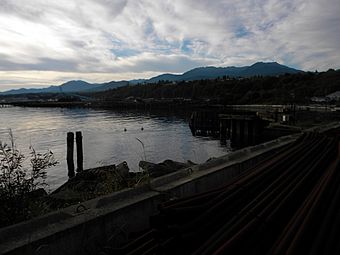Tse-whit-zen facts for kids
Quick facts for kids |
|
|
Tse whit zen Village
|
|

Tse-whit-zen village site
|
|
| Location | Address restricted , Port Angeles, Washington |
|---|---|
| NRHP reference No. | 14000848 |
| Added to NRHP | October 8, 2014 |
Tse-whit-zen (pronounced "chee-WHITS-en") is an amazing ancient village. It belonged to the Lower Elwha Klallam Tribe. The name means "inner harbor" in their language. This village is located in Port Angeles, Washington, right on the waterfront.
Scientists believe Tse-whit-zen is between 1,700 and 2,700 years old. It was discovered by accident in August 2003. Workers were building a large dry dock for ships. This dry dock was for a project related to the Hood Canal Bridge. During the digging, they found parts of the village, including a cemetery.
The discovery was very important because the village was still mostly intact. This means it was well-preserved underground. Because of this special find, the construction project at that spot was stopped. Tse-whit-zen is now known as the largest ancient village site ever found in Washington State. It shows how people lived before Europeans arrived.
Archaeologists have carefully dug up more than 10,000 artifacts. These are old objects made by people. They also found over 335 human skeletons. The Washington State Department of Transportation stopped all construction here in December 2004. Since then, they have worked to protect everything found.
The Lower Elwha Klallam Tribe now owns the land where the village is. This was part of a legal agreement with Washington State. The tribe also received money to build a cultural center or museum. This center will help share the history and culture of their people.
A Village's Long History
The Lower Elwha Klallam Tribe lived at Tse-whit-zen for over 2,700 years. Scientists used a method called radiocarbon dating to figure this out. This method helps tell the age of old materials. The tribe's land stretched from this area to the Hoko River. It also went into what is now the Hood Canal. Tse-whit-zen was one of many villages in their territory.
The earliest signs of people living here date back to 750 B.C. That's around the same time the famous city of Rome, Italy, was founded!
This village was a busy place. It had areas for longhouse structures. These were large homes where many families lived together. There were also special places for ceremonies. The villagers dried fish and clams here too. The Klallam people lived in Tse-whit-zen until the 1930s.
In the early 1900s, businesses built lumber mills on top of the village site. This happened as the lumber industry grew. Luckily, the ground was covered with 15 to 30 feet (about 4.5 to 9 meters) of dirt and fill. This layer of earth helped protect the ancient village and cemetery underneath.
Archaeologists have found signs of possibly eight longhouse structures. These discoveries help us learn about how the Klallam people lived long ago.
Protecting the Past
An important person in protecting Tse-whit-zen was Elder Adeline Smith. She was a member of the Lower Elwha Klallam Tribe. When she was a child, adults warned her not to play on the Tse-whit-zen site. They told her it was a sacred place for her people.
Adeline Smith worked hard to save the village site. She also helped remove the Elwha Dam. This dam had blocked the Elwha River for many years. Removing it helped bring back the river's natural flow. She also helped create a dictionary for the Klallam language. This helped preserve their language in written form.
Tse-whit-zen is the largest ancient Native American village found in Washington state. It teaches us a lot about the rich history of the people who lived there.

